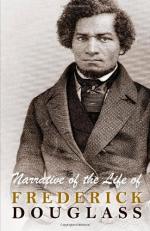|
|
The Narrative of the Life of Frederick Douglass Objects/Places
Talbot County: Frederick Douglass is born in Talbot county, Maryland, where he grows up on the plantation of Colonel Lloyd, a rich landowner. In Talbot county, it is common for slaves to be mistreated. Even murderers of slaves go unpunished.
Great House Farm: The name of Colonel Lloyd's plantation. Douglass spends his early childhood on the Great House Farm. The slaves of the surrounding farms consider working at the Great House Farm a great privilege.
slave songs: Songs with seemingly incoherent words that slaves sing. Some think the songs are evidence of the slave's happiness, but Douglass sees in them a slave's deepest anguish.
Baltimore: When Douglass is six or seven years old, he is unexpectedly sent to live in Baltimore with Captain Thomas Auld's brother, Hugh Auld. Douglass considers the move to Baltimore one of the most significant times in his life. There, he learns how to read and write. Baltimore is the place where he makes his eventual escape to freedom.
The Columbian Orator: A book that Douglass obtains when he is twelve years old, it opens up for him a whole new world of ideas such as freedom, truth, and liberty. After reading the book, Douglass is tormented by the new knowledge of his enslaved condition. Douglass is first introduced to the abolitionist movement through this book.
abolitionist movement: Douglass first comes across this term in the book, The Columbian Orator. After his escape, he is helped by abolitionists and eventually Douglass himself becomes one of the most influential abolitionists of his time.
St. Michael's: When Captain Thomas Auld has a falling out with his brother, Hugh, he takes Douglass back to live with him at St. Michael's. Douglass has been away in Baltimore for over seven years and it is difficult for him to adjust to country life again.
vessels (ships): In working for Mr. Covey, Douglass goes through a low point where he wants to take his life. He looks longingly at the vessels on the Chesapeake Bay because for him, they are symbols of freedom. It instills in him a flicker of hope that keeps him going.
Chesapeake Bay: The ships on the Chesapeake Bay make Douglass long once again for freedom. When Douglass makes his first escape attempt, he plans a route on the Chesapeake Bay.
root: The old slave Sandy Jenkins advises Douglass to carry a root by his right side in order to avoid Mr. Covey's impending punishment. At Sandy's insistence Douglass tries it and it works that Sunday when Mr. Covey does not do anything on his way to church. However, the next day Mr. Covey attacks Douglass. In the footnotes, Douglass mentions that such superstitions are common among the more ignorant slaves.
Sabbath school: A secret meeting of slaves that Douglass organizes to teach slaves how to read. The school meets on Sundays, and grows to over forty slaves. Douglass regards the teaching of these slaves as the most rewarding time of his life.
pass: For the escape, Douglass provides each person with a fake pass he has written just in case they are questioned. When they are caught before their escape attempt, Douglass gets rid of the evidence when Henry Harris causes a commotion with his refusal to be tied. On the way to jail, Douglass tells the others to eat the pass.
Easton jail: Douglass and the other slaves attempting to escape are tied and taken to the Easton jail. Shortly after their imprisonment, slave traders arrive with the anticipation that the captives would be put on sale.
underground railroad: The famous escape passageway in the west. Douglass does not support those associated with the underground railroad who publicize the methods of escape.
New York: Douglass finally succeeds in escaping to the free North when he arrives in New York by train.
New Bedford: Not feeling safe in New York, Douglass settles down in New Bedford, Massachusetts with the help of many abolitionists, mainly Mr. and Mrs. Nathan Johnson.
Lady of the Lake: The title of the book that Mr. Nathan Johnson uses to name Douglass, who is previously known as Frederick Johnson.
North: The area where slaves are legally free, the North represents the land of freedom for the slaves in the South.
The Liberator: An abolitionist newspaper, Douglass is introduced to the issues of the abolitionist movement through 'The Liberator.'
Nantucket: The place where Douglass first shares his experiences as a slave before a white audience.
A Parody: The title of a poem about slavery, Douglass uses it to criticize religious hypocrisy in America.




